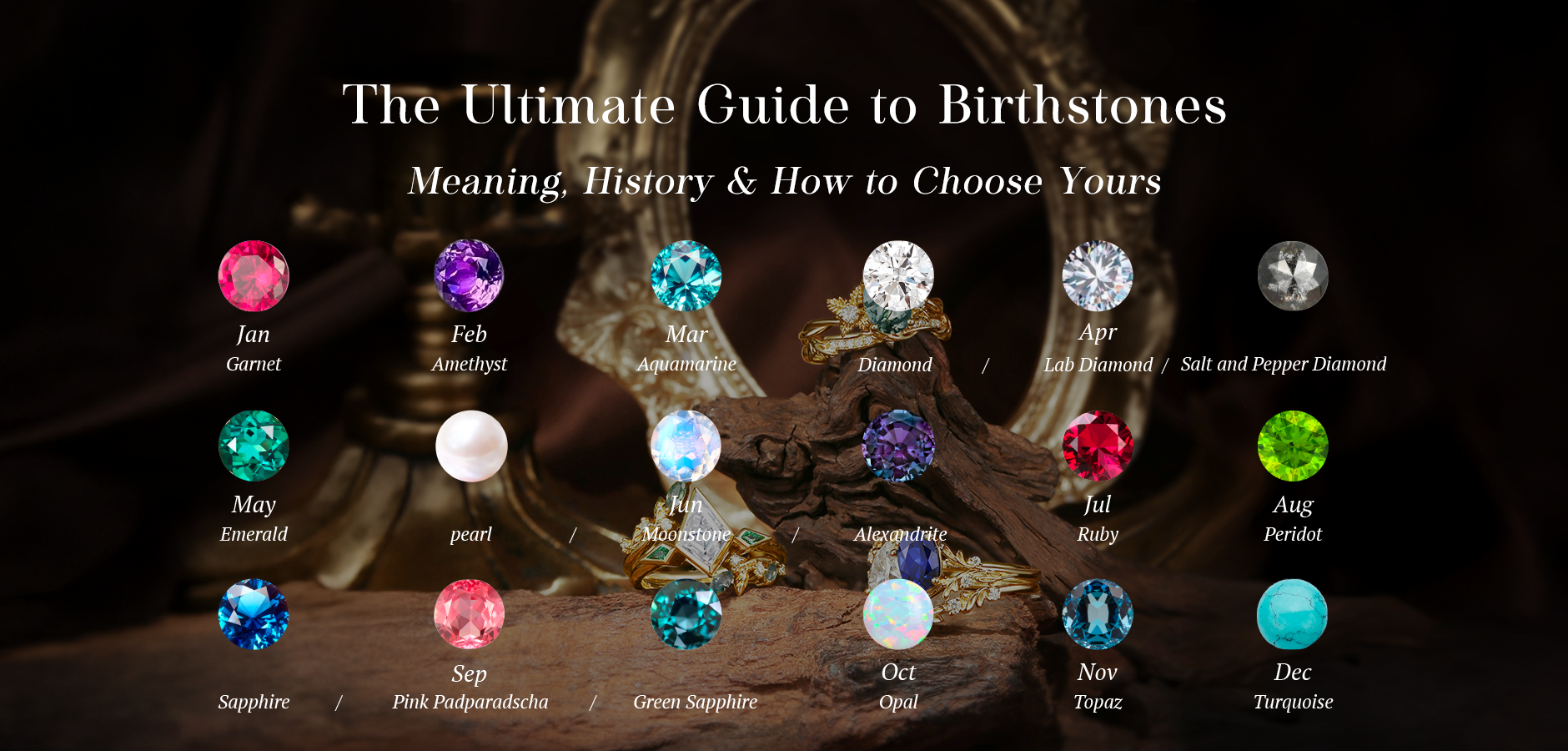For centuries, people have been captivated by the idea that a specific gemstone is connected to their month of birth. These stones, known as birthstones, are believed to hold unique meanings, powers, and historical significance. Whether you're looking for a meaningful gift or a special piece for yourself, this ultimate guide will walk you through the history of birthstones, what each one symbolizes, and how to choose the perfect birthstone jewelry.
A Brief History of Birthstones
The tradition of birthstones is believed to have biblical origins, tracing back to the Breastplate of Aaron described in the Book of Exodus. This sacred vestment was adorned with twelve gemstones, each representing one of the twelve tribes of Israel. Over time, these stones became associated with the twelve signs of the zodiac and eventually with the twelve months of the year.
The modern list of birthstones was standardized in 1912 by the American National Association of Jewelers to promote a consistent and marketable list. This list has been updated occasionally, with new stones like tanzanite being added to modernize the tradition.
The Meaning and Symbolism of Each Birthstone
Each birthstone carries its own lore and is thought to possess certain properties. Here is a breakdown of the traditional and modern stones for each month.
January: Garnet
Symbolism: Protection, Friendship, Trust
The deep red Garnet is most commonly associated with devotion and positive energy. Historically, it was carried as a protective talisman against evil and nightmares. It's said to symbolize a lasting friendship and trust.
February: Amethyst
Symbolism: Wisdom, Sobriety, Peace
This beautiful purple stone has long been connected to royalty and spirituality. It was believed to prevent intoxication and bring a calm, meditative state to its wearer. Amethyst promotes wisdom and clarity of mind.
March: Aquamarine
Symbolism: Serenity, Courage, Health
Aquamarine, with its pale blue hue reminiscent of the sea, is a stone of courage and calm. It was cherished by sailors for safe passage. It soothes fears and encourages clear communication.
April: Diamond
Symbolism: Eternal Love, Strength, Invincibility
The classic Diamond is the ultimate symbol of everlasting love and strength. Its unmatched hardness represents resilience and invincibility. Today, Lab-Grown Diamonds offer an identical, more affordable, and ethical alternative. Salt and Pepper Diamonds, with their unique inclusions, represent beauty in imperfection and individuality.
May: Emerald
Symbolism: Rebirth, Love, Wisdom
The lush green Emerald has been adored by queens and celebrities for millennia. It is a stone of successful love, enhancing fertility, loyalty, and patience. It’s also linked to foresight and good fortune.
June: Pearl, Alexandrite, and Moonstone
Symbolism: Purity, Transformation, Intuition
June has three stunning options. Pearls symbolize purity and humility. Alexandrite is a remarkable color-changing stone that represents balance and joy. Moonstone is known for its connection to intuition and new beginnings.
July: Ruby
Symbolism: Passion, Vitality, Prosperity
The fiery red Ruby is the king of gems, symbolizing deep passion, courage, and energy. It was believed to protect the wearer from harm and attract prosperity and success.
August: Peridot
Symbolism: Protection, Strength, Harmony
The vibrant green Peridot is a stone of protection, believed to ward off anxiety and negative emotions. It symbolizes strength and the promise of new growth and harmony.
September: Sapphire
Symbolism: Truth, Loyalty, Wisdom
While famously blue, Sapphires come in many colors, including the rare Pink Padparadscha and the elegant Green Sapphire. Traditionally, it symbolizes sincerity, truth, and loyalty, making it a popular choice for engagement rings.
October: Opal & Tourmaline
Symbolism: Creativity, Hope, Healing
Opal is famous for its dazzling play-of-color, representing creativity, inspiration, and hope. It was once believed to possess the virtues of all other stones. Tourmaline, which comes in a rainbow of colors, is known as a stone of healing and compassion.
November: Topaz & Citrine
Symbolism: Friendship, Strength, Joy
Topaz, most commonly in a golden blue hue, is a symbol of friendship and strength. Its warm glow is believed to bring joy, generosity, and abundance to the wearer. Citrine, with its sunny yellow color, is also known as the "merchant's stone" for attracting prosperity.
December: Turquoise, Tanzanite, & Zircon
Symbolism: Good Fortune, Success, Peace
Turquoise is one of the oldest known stones, universally recognized for bringing good fortune and success. Its unique blue-green color is calming and is often associated with friendship and peace.
How to Choose Birthstone Jewelry
1. Understand the 4Cs (Beyond Diamonds)
- Color: Prioritize vibrant hues (e.g., ruby’s red, sapphire’s blue).
- Clarity: Emeralds often have inclusions; opals prioritize play-of-color.
- Cut: Cabochon cuts enhance moonstone glow; faceted cuts maximize brilliance.
- Carat: Larger stones may require trade-offs in clarity/color.
2. Natural vs. Lab-Grown
- Natural: Rare, unique, and holds resale value.
- Lab-Grown: Affordable, eco-friendly, and flawless. Ideal for ethical buyers.
3. Design & Personal Style
- Minimalist: Solitaire studs or delicate necklaces.
- Bohemian: Mixed stones or raw gem designs.
- Vintage: Art Deco settings or filigree details.
4. Ethical Considerations
- Choose conflict-free stones and recycled metals.
- Ask for certifications (e.g., GIA for diamonds).
5. Practical Care
- Storage: Keep stones separate to avoid scratches.
- Cleaning: Use mild soap and soft brushes.
- Maintenance: Check settings annually to prevent loss.
Conclusion
Birthstones are a celebration of identity, history, and personal journey. Whether you choose a traditional gem or a modern lab-grown alternative, the perfect piece will resonate with your story. Embrace the magic of birthstones—wear your legacy with pride.
Ready to Find Your Gem? Explore custom designs or timeless classics, and let your birthstone shine as brightly as you do.











